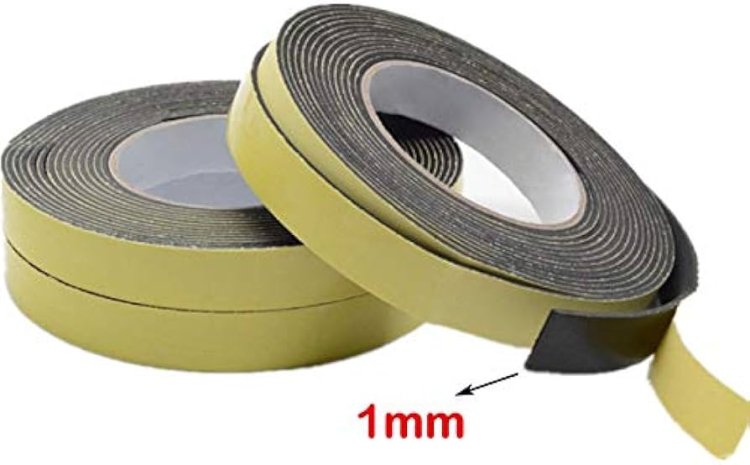Soundproof Your Space: A Practical Guide to Noise Insulation Tape for Peace and Privacy
Discover how noise insulation tape can help you block unwanted sounds, improve acoustics, and enhance privacy at home or work. Learn applications, benefits, and expert tips.

In a world filled with constant noise—traffic, conversations, machinery—finding tranquility can be a challenge. Whether you're working from home, recording music, or simply seeking a quieter living space, soundproofing becomes essential. One of the most overlooked yet highly effective tools in acoustic control is noise insulation tape.
This guide explores what noise insulation tape is, how it works, and how you can use it to improve your environment—whether it’s for a residential, commercial, or industrial application.
What Is Noise Insulation Tape?
Noise insulation tape, often referred to as acoustic sealing tape or soundproof foam tape, is a self-adhesive material designed to reduce the transmission of sound by sealing gaps and absorbing vibrations. It's typically made from materials such as EPDM rubber, foam neoprene, or PVC, and it plays a crucial role in minimizing airborne and impact noises.
Why Sound Leakage Matters
Unwanted noise is not just a nuisance—it can affect productivity, sleep, mental health, and even real estate value. Most sound enters through tiny cracks and gaps in doors, windows, walls, and ductwork. That’s where acoustic tape comes into play. It seals these gaps, dampens vibrations, and helps create a quieter, more controlled environment.
Common Applications of Acoustic Sealing Tape
1. Doors and Windows
Sealing the gaps around doors and window frames with acoustic tape can block outside noise, especially in urban areas. This is particularly beneficial in apartments and office spaces near busy roads or construction sites.
2. HVAC and Ventilation Systems
Duct noise is a common issue in commercial buildings. Soundproofing tape can be applied around HVAC joints and air vents to reduce noise transfer between rooms.
3. Automotive Soundproofing
Noise-dampening tape is widely used in the automotive industry to minimize engine sounds and road noise inside vehicle cabins.
4. Recording Studios and Home Theaters
Studios require precision in sound control. Acoustic foam tape is often used to seal speaker mounts, door frames, and acoustic panels for an echo-free and isolated recording environment.
5. Industrial Equipment
Machines often generate a significant amount of vibration and sound. Applying anti-vibration tape on enclosures and between machinery parts helps reduce operational noise.
Key Benefits of Using Noise Insulation Tape
✅ Effective Sound Dampening
The dense, absorbent materials used in soundproof tape absorb both high and low frequencies, offering comprehensive noise control.
✅ Easy Installation
Most noise sealing tapes come with a peel-and-stick backing, making installation DIY-friendly—no special tools or skills required.
✅ Versatile Use
From residential apartments to data centers and auto workshops, acoustic tape adapts to a wide range of applications.
✅ Energy Efficiency
By sealing gaps, it not only reduces noise but also improves insulation—lowering heating and cooling costs.
✅ Weather and Fire Resistance
High-quality acoustic tapes, such as those made from neoprene or EPDM rubber, also offer weatherproofing and fire-resistant properties, adding to their functionality.
Materials That Matter: What to Look for
???? EPDM Rubber
Durable and weather-resistant, this material is great for outdoor or long-term applications.
???? Foam Neoprene
Flexible and lightweight, ideal for doors and electronic equipment where cushioning is also needed.
???? PVC and Silicone-Based Tapes
Often used in industrial settings for their flame resistance and superior durability.
When choosing noise insulation tape, check for certifications like ISO 10140 (acoustic performance testing) or UL94 (flammability rating) to ensure product quality and safety.
How to Install Noise Insulation Tape: Step-by-Step
1. Clean the Surface:
Remove dust, oil, and debris from the area where you’ll apply the tape.
2. Measure and Cut:
Use a measuring tape to determine the length you need. Cut the tape with scissors or a utility knife.
3. Peel and Stick:
Slowly remove the backing and press the tape firmly onto the surface.
4. Seal All Gaps:
Make sure there are no air leaks by running your fingers along the edges for a secure bond.
Pro Tip: For high-traffic areas like doors, opt for tapes with reinforced adhesive for a longer-lasting seal.
Real-World Use Cases
???? Apartment in Downtown Chicago
A couple used acoustic foam tape to seal their windows and door frames, reducing city noise by nearly 40%. They also noticed their energy bills decreased due to better insulation.
???? Classic Car Restoration
A restoration garage applied EPDM rubber tape inside vintage car doors, eliminating rattles and road noise, improving the driving experience.
???? Call Center in a Business Park
To reduce cross-talk and echo, management installed noise insulation tape on cubicle frames and HVAC vents. The result: improved employee focus and lower ambient noise.
Expert Tips for Maximizing Results
-
Combine with Other Materials: Use alongside acoustic panels, mass loaded vinyl, or door sweeps for full-spectrum soundproofing.
-
Don’t Skimp on Corners: Corners are weak points in insulation. Make sure tape is applied firmly and continuously.
-
Check Compatibility: Use tapes rated for the surface you're working with—metal, wood, plastic, or concrete.
Final Thoughts: Small Investment, Big Impact
While it may seem minor, noise insulation tape can significantly enhance comfort and functionality in both personal and professional spaces. It's affordable, easy to use, and incredibly effective when installed properly. By targeting noise at its source—through cracks, gaps, and vibration points—you can enjoy the benefits of a quieter, more peaceful environment without needing costly renovations or specialized services.
Whether you’re a homeowner looking to block street noise, an audio engineer fine-tuning a recording room, or a business owner optimizing workspace acoustics, noise insulation tape is a practical solution that delivers real results.
Remember: Always choose a high-quality product from trusted brands, ensure proper installation, and consider it as one part of a broader soundproofing strategy.
What's Your Reaction?





















